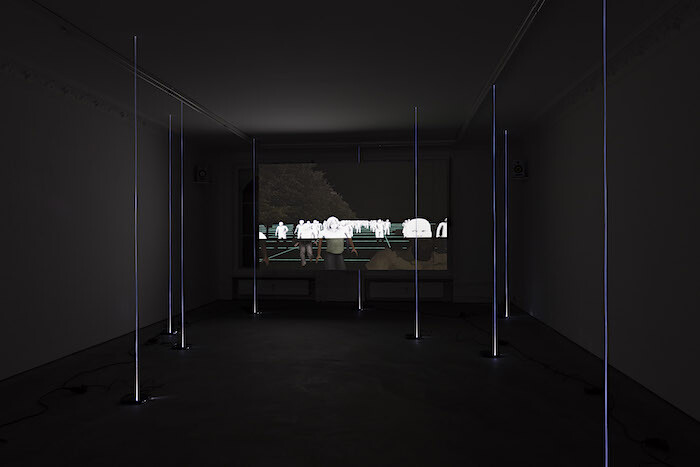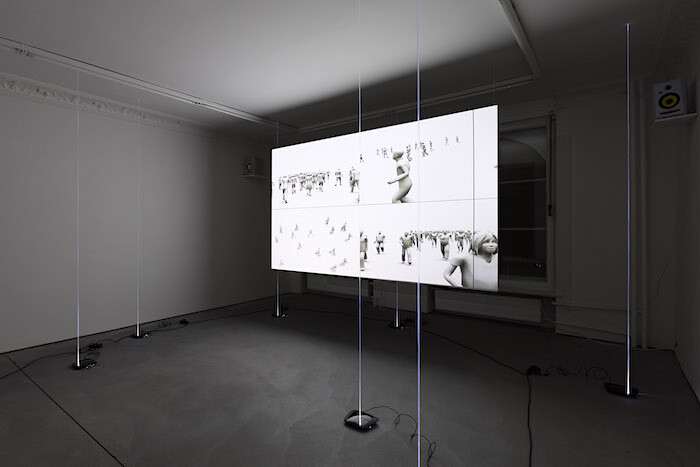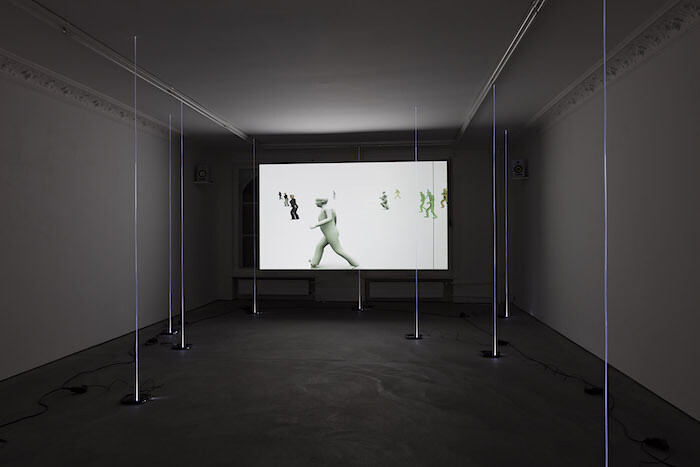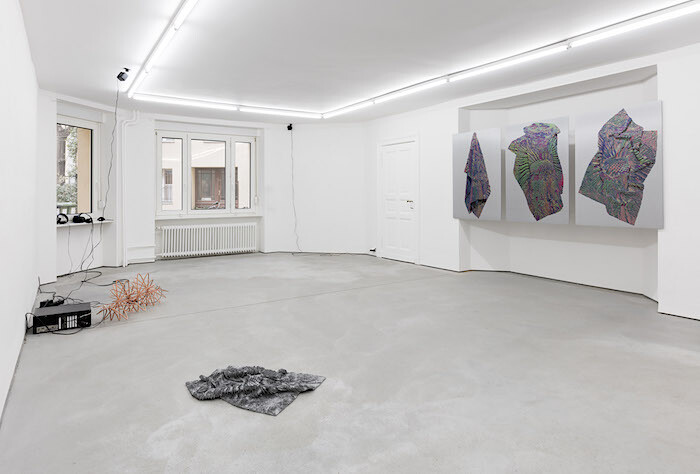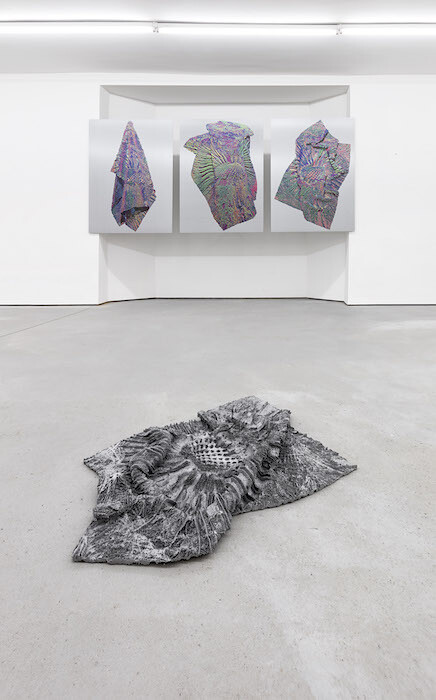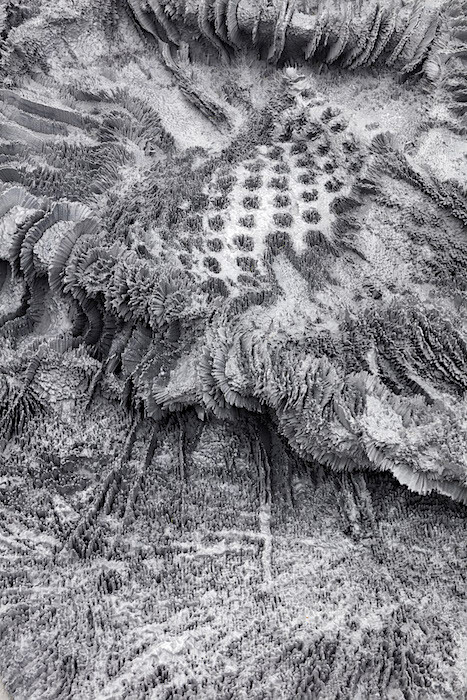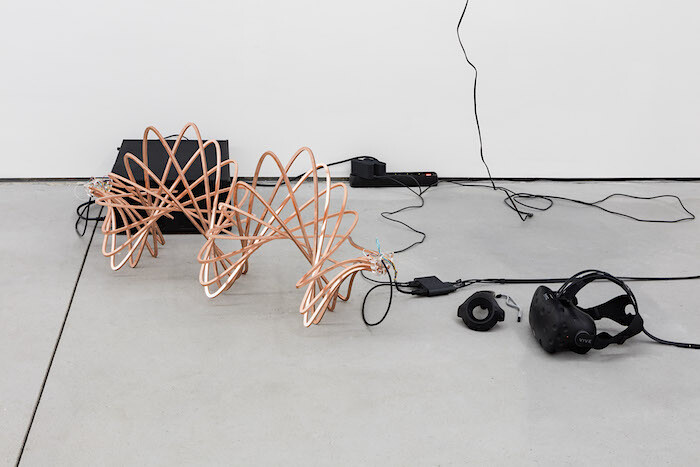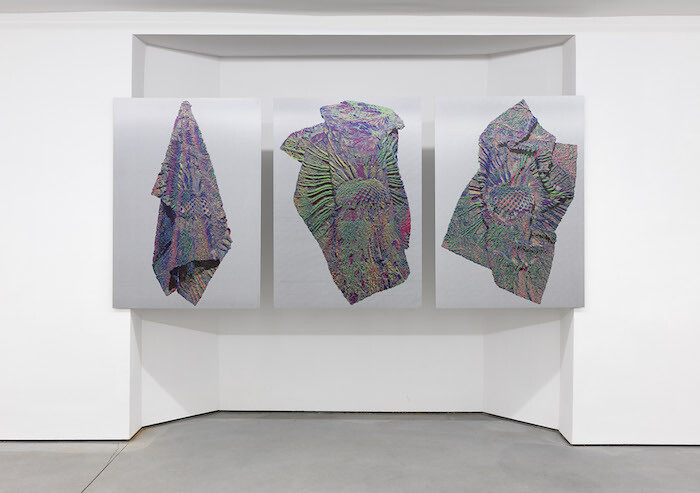Spiros Hadjidjanos’s third solo show at Future Gallery is both technically and conceptually complex—it’s up to the viewer to decide how far down the rabbit hole to go. Yet each work functions on multiple levels, and is rewarding in equal proportion to how much time one dedicates to figuring it out. For instance, one could appreciate Hadjidjanos’s Network/ed Pillars (Taraxacum Officinale Arrangement) (2016) (part of the ongoing project “Network Time,” 2010–2016) installed in a new configuration in this untitled exhibition, solely on the level of aesthetic experience: in a darkened room of the gallery, a group of ten routers is arranged on the floor, each one with a fiber optic cable attached to a blinking LED light on its surface. The cables extend the lights up to the ceiling in long, bright vertical lines, creating a poetic visualization of their fluctuating signals.
Aesthetically seductive, this setup also illustrates several technical processes at work: each router generates an open wireless network and any device within range can automatically connect to one at random. So if someone in the room is connected to a network, the blinking of the respective router will change slightly, hinting at the action. This activity may be (barely) perceptible to someone highly attuned to the working of routers, but one could not decipher without further research that the video work installed in the same room is also being streamed through one of the networks, burdening it with data transmission. There is, in other words, always an active user in the gallery.
The short video streamed by and projected among the routers is titled Crowd Simulation Breakdown (2016). It visually describes the workings of a type of software used to simulate the movement of large groups of people. This technology has been used in various big-budget movies (recently Independence Day: Resurgence, 2016), but also has a wide range of obvious military and governmental applications, including predicting how masses might react in the event of a bombing in a specific train station. In advanced versions of the software, the characters can be given idiosyncratic behaviors, personality traits, or emotional states that cause them to behave as individuals with different motivations.
In Hadjidjanos’s video, rough and clunky outlines of figures running across a gridded plane gradually become fully fleshed humans with outfits and facial features, demonstrating how a series of programmed commands quickly transforms into convincing creatures. Likewise, the crowd’s backdrop becomes gradually more lifelike, and is soon recognizable as Berlin’s Potsdamer Platz, a stone’s throw away from Future Gallery. An eerie soundtrack plays muffled, slowed sounds, which one learns from the press release are adapted from phone recordings made by civilians during the deadliest suicide attacks over the past year, such as those in Nice and Baghdad.
While on the surface it might seem somewhat didactic in its depiction of the realism the software affords, the video cannot and does not explain how the technology actually works. We see the effects, with their host of implications, but not the causes. This crucial tension between what one sees and takes for granted—a blinking LED; a lifelike scene of a swarming crowd—and the intricate underlying processes forms a thematic thread between all works in the show.
For the ambitious work HD/VR Sculpture (2016), Hadjidjanos employed the help of programmers at a Berlin start-up to create a virtual reality landscape. This work forms a new iteration of a long-running series of sculptures in which thick copper wires twisted into the approximation of a 3D sine wave are used to transmit data. Each passive-looking copper object becomes an active conductor as soon as wires are hooked up to both of its ends. In this case, data is sent via the sculpture from a computer to a VR headset. Putting on the headset, one’s perspective is suddenly swung off-kilter: one finds oneself looking up at a giant simulation of the copper sculpture itself. By pressing a button on a hand-held controller, the user can teleport between two scenes (one abstract, the other a kind of lunar landing pad in the midst of a solar system) to view the giant version of the sculpture in different settings.
In contrast to the futuristic nature of the VR work, another series united under the name of “Taraxacum Officinale” (2016) refers explicitly to the historical lineage of mechanical image reproduction. In 1930 the German photographer Albert Renger-Patzsch, a prominent proponent of the New Objectivity school, published a book of flower photographs, including one of a dandelion seed head. The dandelion image is reiterated in each work of the series; for Taraxacum Officinale (xy), the flat image has been extruded with software into three dimensions, and then 3D-printed in aluminum, resulting in a sculpture laid on the floor. For Taraxacum Officinale (zx), (xy), and (xyz), the 3D image itself is then once again flattened, then computationally rotated to be seen from three different angles, each of which is printed on a canvas of woven carbon fiber. If aluminum was the physical substrate of the modernist industrial era, perhaps carbon fiber is this era’s.
Renger-Patzsch and his fellow New Objectivists believed photography should reproduce reality as closely as possible, aiming to embody “the essence of an object.” Whether depicting flowers or industrial machinery, they saw the medium’s value in precise documentation rather than “artistic” expression. But verisimilitude is of course not the essence of reality; the simulation of a crowd running through nearby streets, no matter how advanced, cannot instill the heart-thumping terror of a sudden nearby explosion. Or not yet, anyway. Only a week after Hadjidjanos’s exhibition opening, an as-yet unattributed attack in a crowded Berlin market created a scene not dissimilar to the one imagined in Crowd Simulation Breakdown, adding a new and uncanny layer to the project. As prediction and simulation of experience become increasingly hard to divorce from reality, Hadjidjanos seems to ask, what is really, objectively, happening around us? To find out, we will have to learn to dig past the surface, to investigate the technological processes underpinning what we see.
